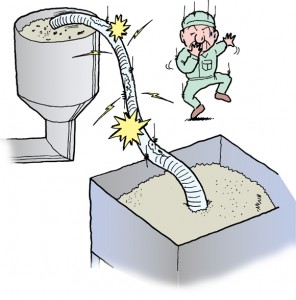Hose and Coupling Knowledge Base
If You Register to Become a Web Member, We Will Send You the Latest Information on Hoses and Coupling.
Beware of Static Electricity on Hoses
This winter, particularly on the Pacific Ocean side of Japan, there is a lot of static electricity, and that affects hoses, too.
During the cooking lessons in elementary school in Japan, there is an experiment where the children take a plastic board and rub it on their clothes, then hold it above their head to make their hair stand up. The experiment teaches the children how static electricity can be generated by rubbing.
Hoses made of plastic also generate static electricity from contact with the fluid passing inside. And like the hair that stands up, the fluid is attracted to the hose surface. This phenomenon is particularly common with powders and granulated substances, which stick to the inside of the hose and impede conveyance. Of particular concern is the static electricity on the outside of the tube. Static electricity that is generated when it is humid rapidly transfers to the moisture in the air because air conducts electricity, but in the winter when it is dry, static electricity accumulates on the plastic surface of hoses. When a person or other object that is a better conductor than air comes close, the static electricity transfers over immediately. That discharge is what causes the shock. If it’s dark, the sparks can even be seen. This can cause fire if highly flammable material is nearby. Static electricity is something that must be taken seriously.

What are some of the measures that can be taken against static electricity on hoses?
Because static electricity is generated whenever friction occurs, it cannot be prevented in hoses. However, it is possible to prevent static electricity from accumulating. To do that, you must create a separate path to divert the static electricity. For hoses, the two methods are: 1) using a hose made of material that prevents a static charge accumulation, and 2) connecting the hose to a conductor such as a ground wire.
For the first solution, the sort of hose that prevents static electricity from accumulating does so by discharging into the air. This is an easy solution. The drawbacks are that it does not completely prevent static electricity, and the effect is not permanent, so hoses need to be replaced frequently to get rid of the dust and dirt that static electricity attracts.
The second solution reliably eliminates static electricity, and the effects are stable and long-lasting. The drawback is that the conductor must be attached to the hose and grounded by the equipment. The selection should be made based on the use environment. Toyox also sells hoses with pre-installed conductors and hoses that can be easily grounded.
> Click here for the TOYOTOP-E Hose for conveying plastic powders and preventing static electricity
Archive
How to Cut Steel-Wire-Reinforced PVC Hose
Does Electricity Conservation Increase Condensation?
Why Do Hoses Leak & Disconnect?
Can PVC & Other Plastic Hoses Be Used for Fuel Gas & Kerosene?
How to Read Catalog Specifications, Part 4 – Are Hose Sizes Random?
How to Read Catalog Specifications, Part 3 – Minimum Bend Radius
Beware of Static Electricity on Hoses
How to Read Catalog Specifications, Part 2 – Negative Pressure+B10
About REACH, RoHS, Endocrine Disruptor & the Food Sanitation Act
How to Read Catalog Specifications, Part 1 – Use Pressure
How to Avoid Damage Caused by Ultraviolet Rays
The Dangers of Hose Condensation
Why Transparent Hoses Become Cloudy
Leaks & Disconnections Due to Mismatched Couplings & Hoses
Causes & Solutions for Leaks & Disconnections
The Benefits of the Right Hose for the Situation (2)









